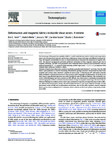Deformation and magnetic fabrics in ductile shear zones: A review
| dc.contributor.author | Ferré, EC | en |
| dc.contributor.author | Gébelin, A | en |
| dc.contributor.author | Till, JL | en |
| dc.contributor.author | Sassier, C | en |
| dc.contributor.author | Burmeister, KC | en |
| dc.date.accessioned | 2017-03-14T15:01:38Z | |
| dc.date.available | 2017-03-14T15:01:38Z | |
| dc.date.issued | 2014-01-01 | en |
| dc.identifier.issn | 0040-1951 | en |
| dc.identifier.uri | http://hdl.handle.net/10026.1/8615 | |
| dc.description.abstract |
The Anisotropy of Magnetic Susceptibility (AMS) is a well-established petrofabric tool for indicating relative strain and microstructural character and has been validated on various rock types and different structural settings. The magnetic susceptibility of a rock (K) depends primarily on the nature and abundance of magnetic minerals. The physical arrangement and lattice-preferred orientation of these magnetic minerals give rise to magnetic anisotropy. The AMS scalar parameters most commonly used to constrain strain include the corrected degree of anisotropy (P'> 1), a proxy for fabric intensity, and the shape factor (- 1 ≤ T≤ + 1), an indicator of the magnetic fabric symmetry (prolate vs. oblate).A number of studies have shown that a positive correlation generally exists between P' and strain. Thus, the AMS shows a great potential as a tool for examining deformation in geologic structures characterized by large strain gradients such as shear zones. However, a number of caveats exist: (i) The increase of P' with strain cannot be solely attributed to deformation because P' also increases with K regardless of deformation; (ii) Strain across shear zones is typically heterogeneous and is often localized in units of different lithology, thus making the separation of the lithological and strain controls on AMS difficult; also, deformation is commonly accompanied by mineral segregation or fluid-rock interaction that induces changes in magnetic mineralogy; (iii) Even if the undeformed lithology was uniform across a shear zone, variations in strain rate or temperature may result in different deformation mechanisms; hence, the relationship between P' and strain depends strongly on both the mineral carriers of AMS and on deformation mechanisms; and (iv) The AMS is unable to resolve composite fabrics, such as those resulting from S-C structures, where minerals on the C and S planes, respectively, contribute to AMS. | en |
| dc.format.extent | 179 - 188 | en |
| dc.language.iso | en | en |
| dc.title | Deformation and magnetic fabrics in ductile shear zones: A review | en |
| dc.type | Journal Article | |
| plymouth.issue | C | en |
| plymouth.volume | 629 | en |
| plymouth.publication-status | Published | en |
| plymouth.journal | Tectonophysics | en |
| dc.identifier.doi | 10.1016/j.tecto.2014.04.008 | en |
| plymouth.organisational-group | /Plymouth | |
| plymouth.organisational-group | /Plymouth/Faculty of Science and Engineering | |
| plymouth.organisational-group | /Plymouth/REF 2021 Researchers by UoA | |
| plymouth.organisational-group | /Plymouth/REF 2021 Researchers by UoA/UoA07 Earth Systems and Environmental Sciences | |
| dc.rights.embargoperiod | Not known | en |
| rioxxterms.versionofrecord | 10.1016/j.tecto.2014.04.008 | en |
| rioxxterms.licenseref.uri | http://www.rioxx.net/licenses/all-rights-reserved | en |
| rioxxterms.type | Journal Article/Review | en |


